Wood for Thought

Patrick Dougherty ’67 used to try to mimic the way birds weave twigs for nests. He couldn’t. But the art that rustled within him — that, he could do.
by Jason D. Smith ’94
Patrick Dougherty ’67 is out of sticks. He knows he can get more, but the sculpture he’s building with a small army of volunteers at the N.C. Botanical Garden in Chapel Hill is supposed to wrap in three days: The garden wants to hold a naming ceremony. Dougherty has used at least 20 truckloads of saplings, and the sculpture isn’t finished.
So eight or 10 of us are in the woods just north of town, cutting. Dougherty doesn’t seem perturbed. He’s cut from this spot a few times before. He’ll spend the day here, with two shifts of volunteers, and cut enough saplings to finish. Cutting lines, he says.

Patrick Dougherty (Photo by Jason D. Smith ’94)
He thinks in lines. To make a piece that fits its site, one that feels comfortable and familiar there, he sketches some rough concepts in his mind, then on paper. Eventually he abandons the sketches and lets the sculpture grow, stick by stick. Stick by stick, volunteer by volunteer, the sculpture at the garden gets done. The naming ceremony proceeds. Homegrown, three weeks in the making and the size of a small cottage, sits behind the garden’s main building, and from inside it visitors can look out onto flowerbeds and plantings. Like almost all of Dougherty’s works, it’s more or less temporary: An outdoor sculpture made of sticks will last until it doesn’t.
Over the past three decades, Dougherty has built somewhere north of 230 such works on at least four continents, in 17 countries, 40 U.S. states. Chapel Hill, Miami, Manchester. Melbourne, Chateaubourg, Copenhagen, Sheboygan. Weizelsdorf. Kalamazoo. Mishima, Clemson, Quebec. Sioux City. Each work takes him three weeks; he spends a week between gigs at home in Chapel Hill. He’s learned to limit his bookings so he can better respond when interesting opportunities sprout up. Still, he’s booked through 2016.
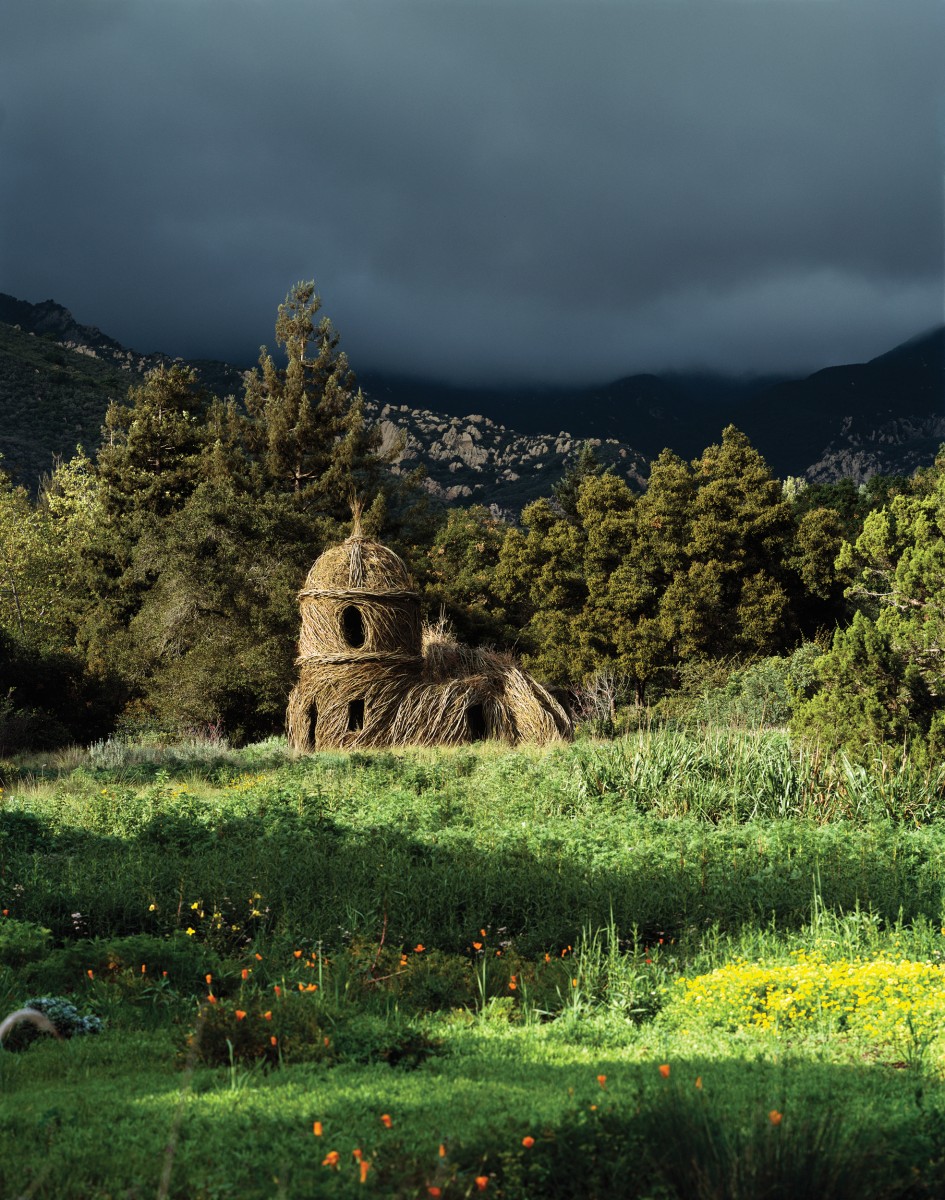
Toad Hall, 2005, in the Santa Barbara Botanic Garden, Santa Barbara, Calif. Here, in willow, an enclosed courtyard backed a domed tower. A tunnel inside allowed visitors to make a circuit of the piece. As they did so, many would discover a second secret passage that meandered through the courtyard. Part of Dougherty’s California Mission series, Toad Hall evoked the historic Mission Santa Barbara. He imagined the pieces in this series as “contemporary art outposts.” In his book Stickwork, he writes, “Toad Hall was one of the best building experiences of my art career. … [I]t was hard for me to say good-bye.” (Photo by Nell Campbell, courtesy of Santa Barbara Botanic Garden)
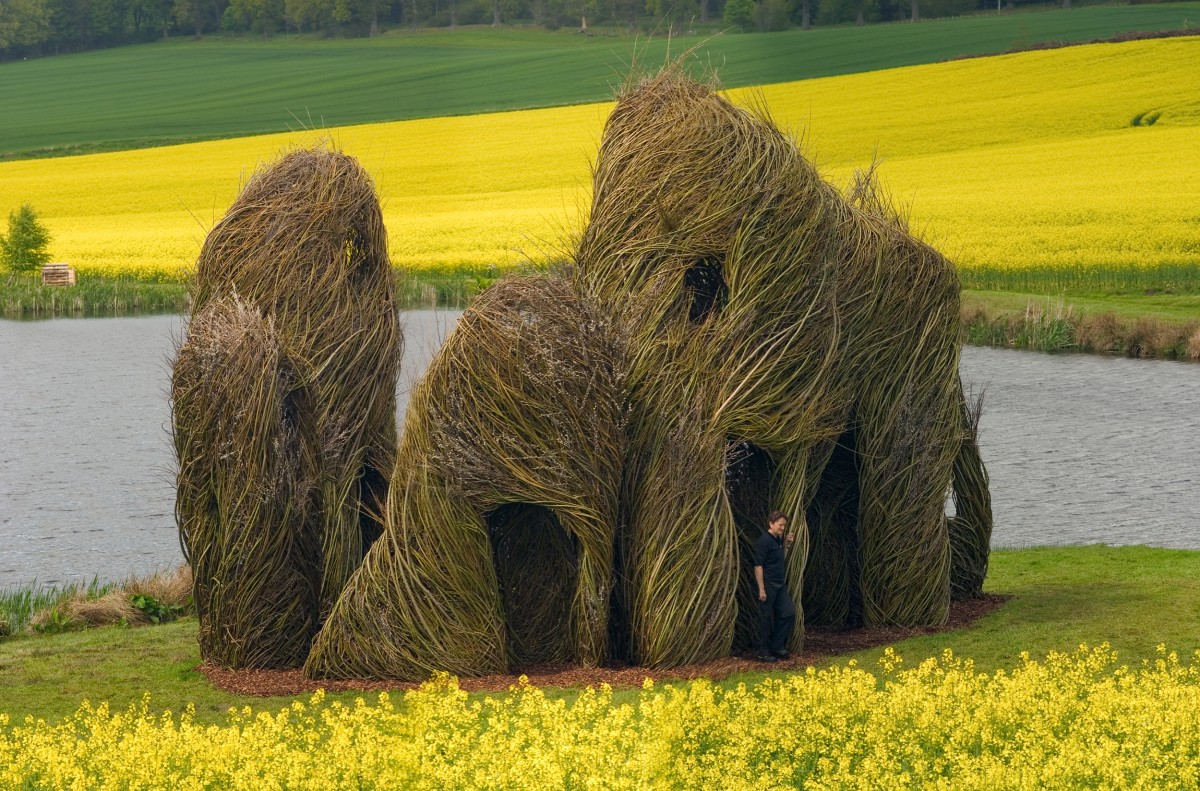
Close Ties, 2006, Scottish Basketmakers’ Circle, Dingwall, Scotland. Willow, inspired by an ancient stone circle near the village of Callanish. After being on display for a year, it had what Dougherty calls a “spectacular send-off,” as locals held a music and dance festival to burn it. (Photo by Fin MacRae, courtesy of Basketmakers’ Circle)
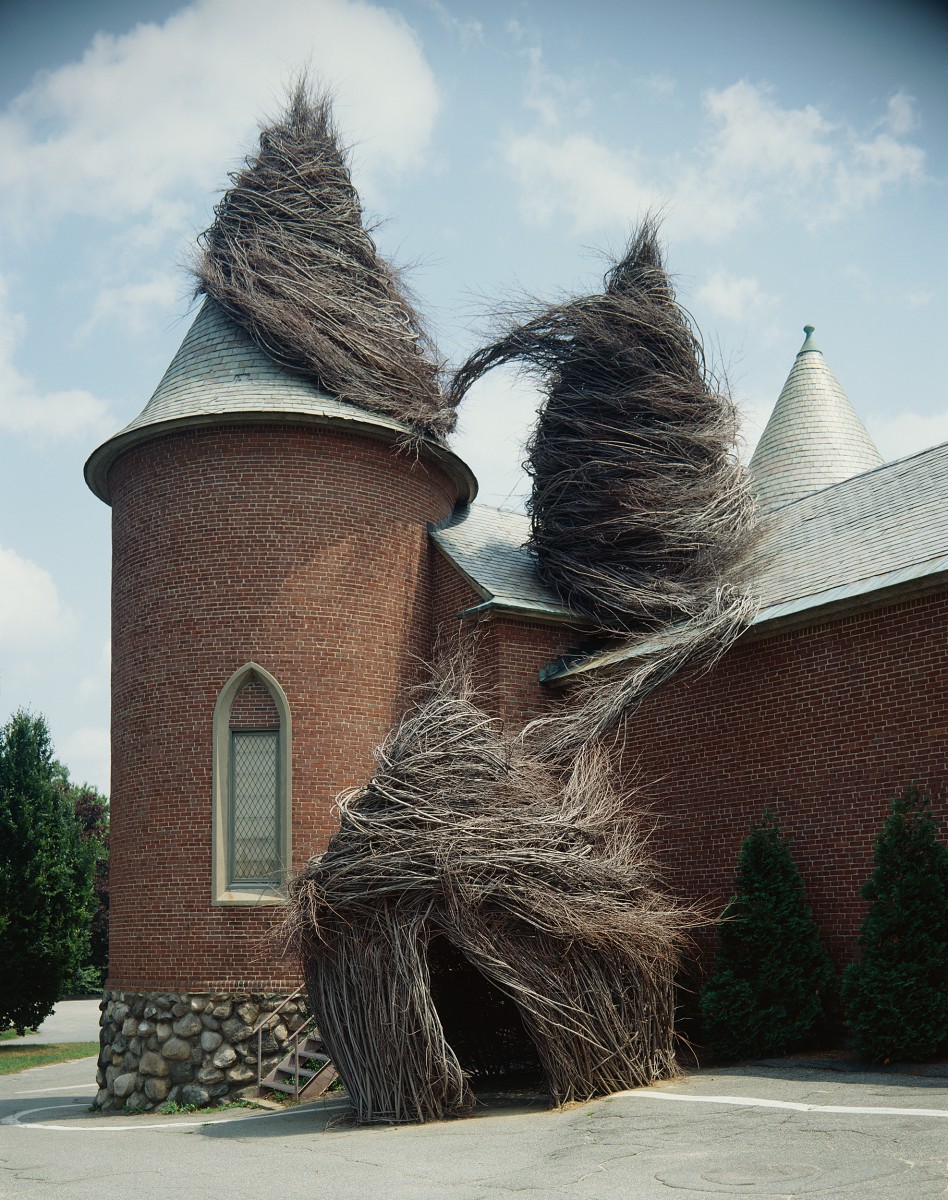
Spinoffs, 1990, at the DeCordova Sculpture Park and Museum, Lincoln, Mass. Red maple. (Photo by George Vasquez, courtesy of the DeCordova Sculpture Park and Museum)
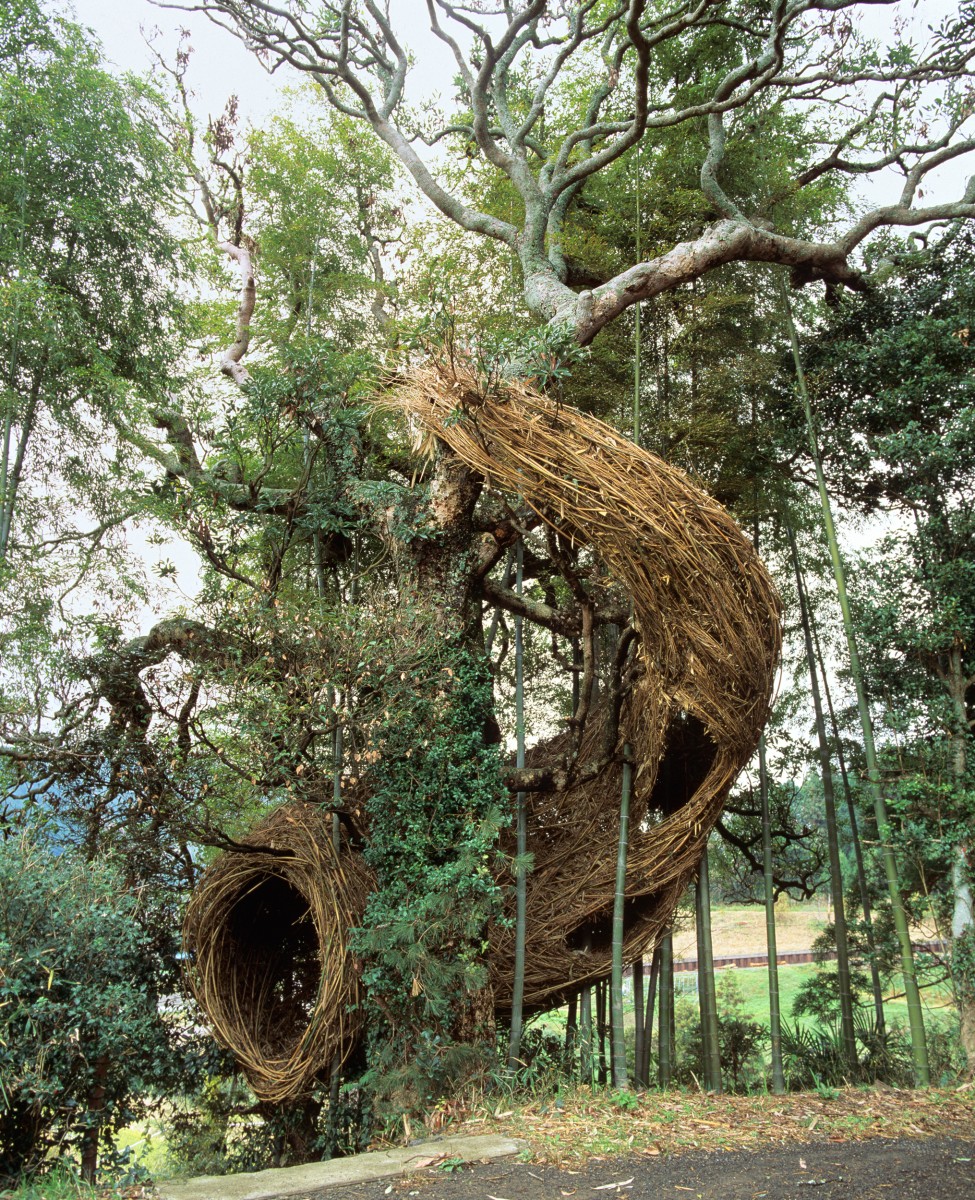
Holy Rope, 1992, Rinjyo-in Temple, Chiba, Japan. Bamboo in an ancient oak evokes the rice rope that often adorns very old trees in Japan. Dougherty built it while living in a 400-year-old temple that was otherwise occupied only by monkeys and snakes. “Don’t kill the snakes,” the caretaker warned, “but if one bites you, call my wife, who will take you to the hospital.” Dougherty writes: “That was little comfort, since I knew his wife did not speak a word of English.” (Photo by Tadahisa Sakurai, courtesy of Ikebana Ryusei)
The art ache
Dougherty’s job, he says, is to do something compelling, something that reveals itself, speaks its own mind. “You realize it’s sticks,” he said, “but at the same time, your imagination is jumping just a little beyond sticks. You’re being compelled by the line. There’s a level of amazement, because you don’t think that humans work with sticks, you think that birds do. It pulls you into something about simple shelter, something about basic building, something about atavistic feelings or building techniques.”
Dougherty grew up in a Southern Pines house with no tools in it: His father was a medical doctor; Dougherty’s grandfather, not wanting his son to become labor for hire, had actively discouraged the eventual Dr. Dougherty from learning to fix things. Dougherty’s mother was what he calls a Sunday painter. His maternal grandmother “was a farm woman,” he said, “who, amidst her other chores, would paint, amazingly so. Big country woman. Untrained.”
Now 69, Dougherty is broad-backed, white-crowned, tall. He speaks deliberately, diplomatically, having spent more than a few years managing groups of volunteers that have more enthusiasm than know-how. Rolling down the highway in his truck, he will assess patches of saplings with a glance. When pausing to take the measure of something or someone, he has a habit of peering over his glasses, which are a little more chic than you’d expect for someone who raised his own house from raw Chapel Hill timber and stone and sweat.
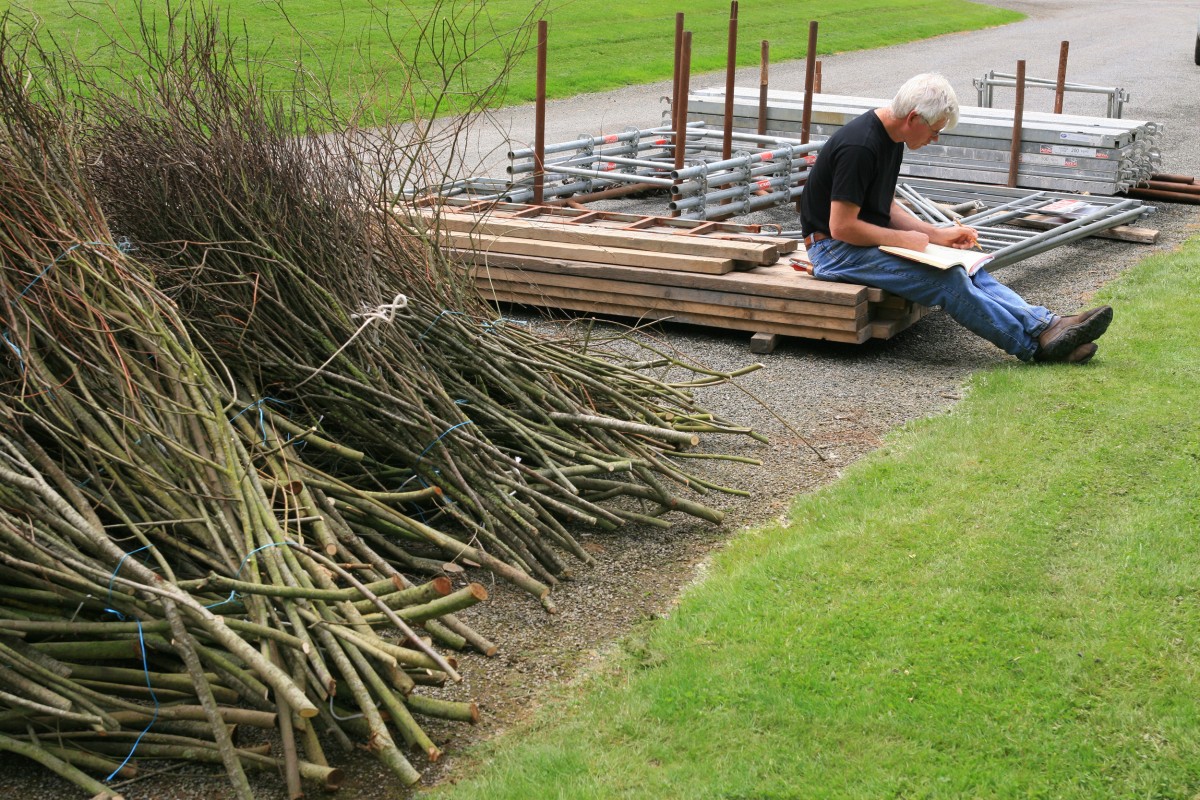
Dougherty works on sketches for Sortie de Cave in Chateaubourg, France. (Photo by Charles Crie, courtesy of Jardin des Arts)
In Dougherty’s complete chronological list of works, the first entry, from 1977, is Handmade House. It sits in thick woods a few miles west of town. It seems enchanted, like some fairy-tale dwelling, as if it was built by someone who had more imagination and patience than hands-on experience. He did.
He was in his late 20s in the early ’70s, with a bachelor’s in English from Carolina, a master’s in health administration from Iowa, a stint in the Air Force and a few years as a hospital administrator. On the Iowa campus he had discovered an ache. “I often remember looking longingly at the art department, at their studio doors, and thinking, ‘Oh, I wish I could do that. I know I can’t; I’ve gotta be a responsible human being. I can’t be a sculptor.’ ”
He moved to South Carolina to run a vocational rehab center. He started looking at derelict log cabins and tobacco barns. Then he started doing more than looking: He bought; he deconstructed; he stockpiled beams and logs and timbers, plotting.
In 1975, he put it all on a truck, quit his job and bought 10 Orange County acres for $10,000. He thought he was coming back to Chapel Hill to build a house.
He rememebers thinking, ‘Oh, I wish I could do that. I know I can’t; I’ve gotta be a responsible human being. I can’t be a sculptor.’
“Stick-built.” In the housing trade, it means made on site, not modular or factory-built. Dougherty’s cabin is stick-built, log-built, rock-built, Dougherty-built. He dug stone for a back wall two feet thick and 15 feet long. He notched and fitted. He herringboned saplings across the ceilings. He split a hollow log lengthwise and hung it over the front steps as a gutter. (Years later, The New York Times would call the house Dougherty’s only permanent work.)
By 1980, the cabin was complete but Dougherty was still aching. He enrolled in some art courses at UNC, often bringing his kids to class with him. He wasn’t much aware of what was going on in the art world, so he might have been a little prickly toward some of his professors. He remembers asking them things like, why does that person have a right to do that? Why did they paint that board blue? He’d tell his professors, no, that’s not right. But he wanted what those artists had. Even while he was challenging the nature and the utility and the value of art, what he wanted, he says, was art.
He considered sticking around for an MFA but eventually realized that if he were really going to become a working artist, he had better become a working artist. His second stickwork was called Maple Body Wrap, and when he exhibited it in his final student show it took root in the mind of a curator at the N.C. Museum of Art, who encouraged him to submit it to the 1982 N.C. Artist Exhibition. Commissions started coming in from across the state. His sculptures grew larger, and by 1986, he crossed state lines for the first time to do an installation, his 12th, in Tampa, Fla.
In 1987, at the Market House in Fayetteville where slaves and other sundries once were sold, he used maple to shackle the building. Some Fayettevillians objected — the building was important, and Dougherty had been allowed to remove very old panes of glass so that sticks could go out one window, around the corner, and back in another. Cornering the Market stood for three of its allotted six weeks before the city council, citing fire safety and the alteration of a historic building, unanimously voted to have it removed. The glass was replaced, safe and sound.
Back then, public art wasn’t as common as it is now, and Dougherty says he was “really a bit player in a drama that asked if art is good for the public.” He’s since learned to work with community organizations, build a piece, then invite the general public over to see it.
He occasionally hears grumbles from people who wonder
about the environmental effects.
In 1990, he wrapped the roof of a museum in Lincoln, Mass., with red maple that capped the museum’s conical tower, spilled over to form a second cone on the building’s lower roof, and then ended in a primitive cone-shaped dwelling on the ground. To get enough saplings for the work, he spent several days unsuccessfully telephoning what was then known as Concord Prison, which owned some maple-rich land nearby. Frustrated, he mustered some photos of his past work and broke protocol by driving into the facility to ask for the warden. “Take the damn saplings,” the warden said, “but get out of my prison.”
No going this alone
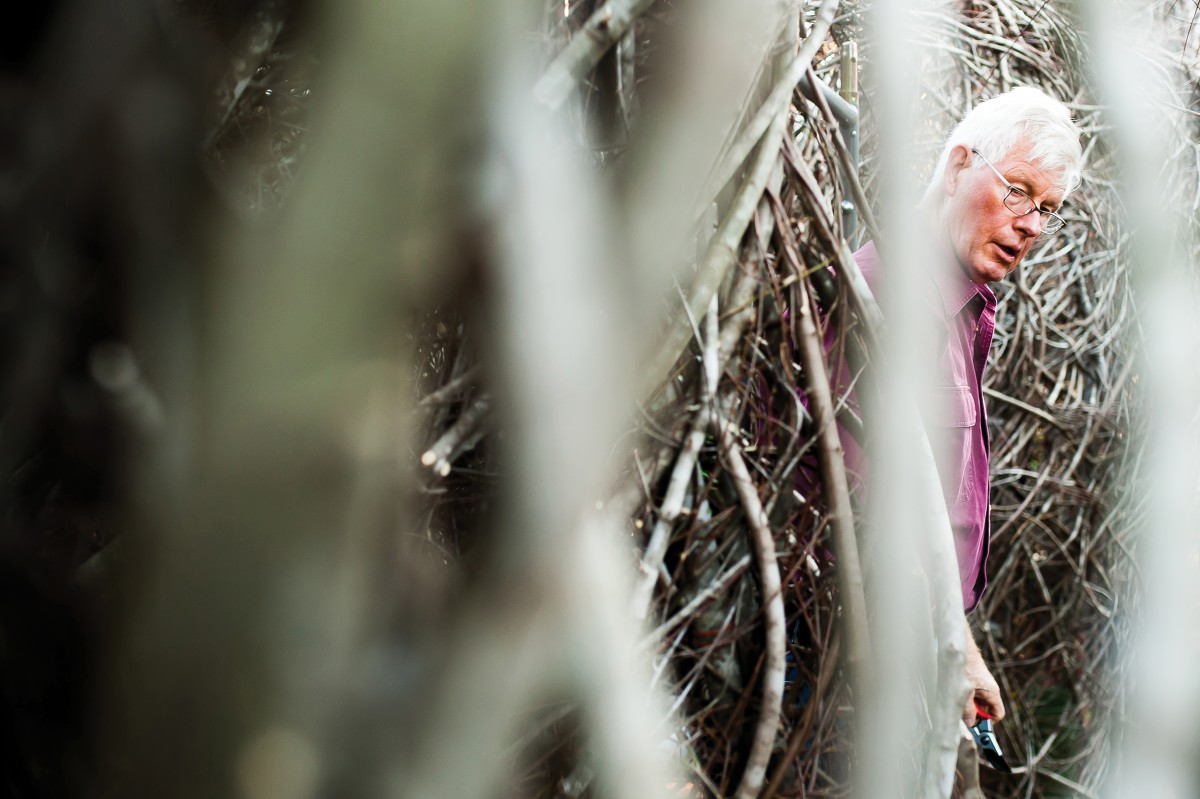
Dougherty works on the sculpture installed last fall at the N.C. Botanical Garden. (Photo by Shane Snider)
In arrangement with volunteers and sponsoring agencies and landowners, Dougherty gathers truckloads of sticks from places they’re generally not wanted: undergrowth from managed forest land, early regrowth from land that’s been cleared but not yet built upon, marginalia from public works areas such as power lines and water treatment plants. Still, he’ll occasionally hear grumbles from people who wonder about the environmental effects.
“I don’t put anybody down; it’s a complicated question. We’re a wood-based society. Our newspapers are wood; our floors are wood; our best furniture is wood. So in some ways it’s credible to say that making something of beauty out of sticks is fine, too. But we have a knee-jerk reaction to the idea of ‘baby.’ We feel like if it’s a small tree, it’s got all this growth potential, and somebody’s just yankin’ it up.” He points out that in places like North Carolina, saplings will sprout right back up.
He tries to live simply. “I have no desire to live in more than 900 square feet. I try to gather things, try to use things well, try to do anything I can to mitigate the circumstance. But I don’t think getting mad at people is the way to do it. I think you have to have a conversation and not get on your high horse.”
He reminds his volunteers that when they were kids they used sticks every day — as tools, as weapons, in make believe. He tells them that out ancestors passed down to all of us a basic stick know-how. He assures them that they can build, and they do.
He says that in the past he’s tried to mimic the nest-weaving of birds but can’t. Instead he does what he calls haphazard snagging — flexing and dragging a stick through those around it to weave a kind of fabric. (While clearing land for his cabin, he noticed how the saplings he dragged out of the woods would tangle and hang on just about anything.) Most branches and saplings and sticks are tapered, and Dougherty orients them such that the tapers create the impression of movement. He crosshatches with sticks; he uses them as shading lines.
He goes back over a work in its final stages to add strategic lines, accent lines, thrusts of movement. For Homegrown at the Botanical Garden, he placed the sticks to create what he called a tension between constraint and escape: The bottom of the sculpture seems more controlled, while above eye level the sticks become more unruly, breaking free from the top of the piece.
Twenty-five years ago, he told The Fayetteville Observer that he became an artist because he wanted to work with his hands, not with people. It didn’t work out. Today on an installation, he’s part foreman, part host, art instructor, camp counselor, public relations specialist. The volunteers maybe doubt themselves. He reminds them that when they were kids they used sticks every day — as tools, as weapons, in make believe. He tells them that our ancestors passed down to all of us a basic stick know-how. He assures them that they can build, and they do.
“One of the main things they bring is a lot of non-prejudicial energy. They’re giving you their best possible shot; there’s no negativity that flows in and around this thing. They just want to come and help you, and they’re not really sure what that means. But out of that, I think the piece moves forward in a very compelling way. … In terms of whether they put a line here or there, sometimes people will do things, and I’ll say, ‘Stop. That’s really good. Let’s do more of that.’ ”
He loves when passersby stop and ask what he’s doing. He sometimes turns one question around: Well, what do you think it is? The conversations give him new ideas, help him come up with titles. A little boy at an indoor installation in Seattle told Dougherty it looked like a plate of spaghetti had spilled and a meatball had rolled down the stairs. Pasta of alder and dogwood and maple. Speedball, 1990.
Dougherty and his volunteers work rain or shine, and there have been three-week projects without a day of the latter. And stickwork is surprisingly physical; I was banged up and muddy and sore after helping with the project at the Botanical Garden.
It’s something Dougherty, no sapling himself, has thought a bit about. “I think that I’ve always tried to do what I seem compelled to do. As long as your health holds out, you can work hard. … But I think the material is promotive. Those saplings are really connected with our hunting and gathering past.”
When we pick one up, he said, we get in touch with needs that humans have always had — for safety, for tools. Utility. “It starts certain juices flowing about simple shelter, about the Garden of Eden, about divesting yourself of personal possessions and just being one of the animals. It kind of goes back to feeling a little more basic for a minute. It’s illusionary in some ways, but nonetheless profound.”
Jason D. Smith ’94 is associate art director of the Review.
More of Dougherty’s work can be seen at www.stickwork.net; more about the N.C. Botanical Garden and Homegrown can be found at ncbg.unc.edu/home.
Thanks for reading the Carolina Alumni Review
Carolina Alumni members, sign in to continue reading.
Not yet a member? Become one today.
